Immerse yourself in Burgos's vibrant flavors and uncover hidden culinary gems with our expert insider guides. Plan an unforgettable trip today!
Read more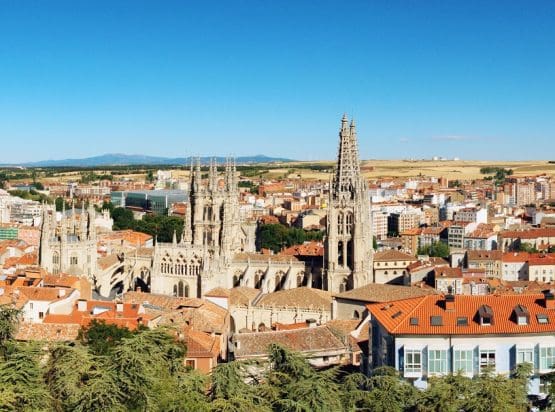
EXPLORE ALL OUR CASTILLA Y LEON WINE REGIONS GUIDE
Last updated: October 11, 2024
In the 20th century, Spain forged an overarching reputation based on its versatile and delectable red wines; Rioja, Ribera Del Duero, and Priorat are now all major household names. From London to New York, you’ll hardly come across a wine store or restaurant list that doesn’t contain at least a broad selection of Spanish wines. Yet the last fifteen years have also seen a phenomenal explosion of delicious, zesty whites coming from Spain, with the massive buzz surrounding regions like Galicia’s Rias Baixas and Valdeorras, important sources of the mega-trendy Albariño and Godello. Modern Spain, dynamic and innovative, wears its diversity on its sleeve.
However, the greatest revolution to have taken place in Spanish white winemaking occurred in the vineyards of Rueda in northwest Spain. Indeed, Rueda can legitimately claim to be the Godfather of modern Spanish whites: Rioja stalwart Marques de Riscal started the ball rolling in the 1970s, transforming a forgotten part of Castilla y Leon into an epicenter of aromatic white wines. The region hasn’t looked back since new bodegas, high-class tourism facilities, and a stylistic divergence away from the ‘unoaked and fruity’ stereotype keep the DO relevant and exciting. With the new ‘Gran Vino de Rueda’ category entering the fold, there’s no chance of Rueda going stale.
Discover more about Spanish Wine
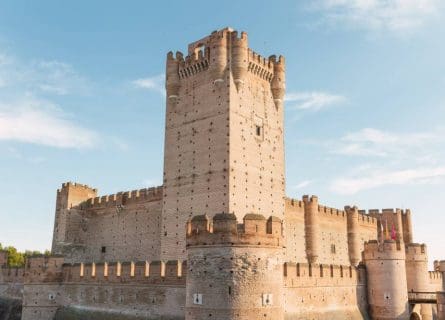
Winegrowing has been a feature of life in Castilla y Leon for many centuries. The Romans were its biggest champions, planting vines throughout their dominions in Western Europe. Over a quarter of the world’s population lived and died under the Caesars until the Western Roman Empire collapsed under the weight of its own hubris.
Subsequently, the Iberian Peninsula was left at the mercy of various barbarian tribes from Northern Europe, including the Suebi, Vandals, and Visigoths. The latter managed to establish a capital in Toledo in Castilla la Mancha, although their authority over the country was tenuous from the beginning.
This opportunity was exploited by the Moorish general Tariq, who landed an army in Andalucia in 711. A combined force of Arab and Berber soldiers easily overcame the weak and disorganized Visigoths; Castilla Y Leon was a Muslim province for over three centuries. Absorbed into the kingdom of “Al Andalus,” northwestern Spain waved goodbye to viticulture and other Christian traditions. Yet the Moors employed sophisticated agricultural techniques – they invented the water wheel – to revolutionize food production across the peninsula.
Nevertheless, a Reconquista led by the Christian monarchs began earnestly in the 10th century. Both sides fought with gusto and courage, although by the 1100s, Christian armies had gained the upper hand. As a result, many displaced Muslims fled into southern Spain in the 13th century; the marriage of Isabel of Castile and Fernando of Aragon in 1469 was the final nail in the coffin for the Moors. Their combined forces created an unstoppable army – Isabel and Fernando retook the last Moorish stronghold of Granada in 1492. Meanwhile, the small province of Navarra became part of a unified Spanish state in 1512.
Rise of Rueda and the Verdejo Grape
The kingdom of Al Andalus was no more; viticulture returned to Castilla y Leon in the Middle Ages, encouraged by the arrival of Cistercian monks from northern Europe – Spain’s self-appointed wine guardians! However, it was not until the 18th century that the now-signature Verdejo grape was planted in the Rueda zone; its popularity soared, and the harvests became spectacularly large, far greater than anything seen currently in the region.
Yet the wines of mid-19th century Rueda didn’t resemble the clean-cut, appetizing thirst-quenchers we enjoy today. On the contrary, Rueda wines were classically vinified and fortified like sherry, made in a style that would be a complete anathema to today’s consumers. Tragically, phylloxera wiped out most of the acreage in the late 1800s until very few vines were left. The industry was devastated.
Fortunately, a turnaround came in the 1970s when leading winery Marques de Riscal explored the possibility of modern white winemaking in Rueda. In 1972, Riscal founded its winery in Rueda, which was dedicated to making white wine, creating a new style, and recovering the Verdejo grape – Spain’s answer to New World aromatic whites!
Marques de Riscal continued to play a pioneering role, introducing the now ubiquitous Sauvignon Blanc to Rueda in 1974 and finally establishing a formal appellation or Denominación de Origen in 1980.
Then other investors caught the scent, flocking to the vineyards of Castilla y Leon as the market for saline white wines exploded into the late 20th century. At the same time, a younger generation of post-Franco winemakers brought modern techniques and a more international outlook to Spanish winemaking. Today, the DO has gone from strength to strength, with a bold new vision to target wealthy consumers with a luxury tier of wines: Gran Vinos de Rueda.
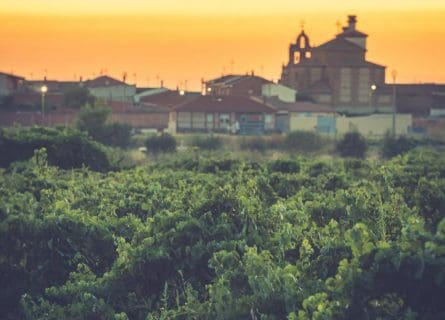
Rueda is a jewel in the vast expanse of Castilla y Leon. Its vineyards are located south of Valladolid in a rapidly expanding zone encompassing La Seca, Rueda, Serrada, and Rodilana wine villages. The most important landmark is the river Duero – or the Douro in Portuguese– which flows into the famous red wine zone of Ribera Del Duero.
Mirroring the conditions in neighboring Ribera del Diero, the region’s climate is primarily continental, offering growers sometimes bitterly cold winters and hot summers. The average daytime temperature in the summer is around 86° F, although this drops considerably at night. Indeed, diurnal temperature variations are key in maintaining the all-important acidity and freshness in the wines.
Diverse Terroir
However, Rueda’s terroir is far from homogeneous. The soils in the region are predominately poor and infertile, ideal for keeping yields sufficiently low for producing high-quality wines. The vineyards near the Duero River benefit from the alluvial deposits and high lime content in the soil; these are considered some of the finest sites for making age-worthy, structured wines.
Growers and producers jealously guard the locations of their most prized vineyards, usually old bush vines that give low yields and are planted on extremely poor, gravelly soils. Elsewhere, there is more sand in the topsoil, typically found in the middle and lower areas of the old Duero terraces.
Verdejo: The Mainstay of Rueda’s Wine Production
The charming Verdejo grape planted across the zone remains the mainstay of production in Rueda. It is Spain’s answer to Sauvignon Blanc. It blends well with the other permitted white varieties, which include Rioja’s Viura, Sauvignon Blanc, Chardonnay, and now Viognier. A smattering of red grapes—Tempranillo, Merlot, and Garnacha—are also planted. However, these are primarily inconsequential compared to the volume of premium whites produced in the region.
Rueda is a relatively young appellation within Spain’s mosaic of established DOs, yet its wines have quickly become a hit with consumers both within and outside of Spain. The timing of its rise to prominence was most opportune: consumers have rejected heavy and extracted styles in favor of gracefulness and lower alcohol. So, in an era where people love fresh, clean, and aromatic whites, Rueda ticks all the boxes.
However, the regulations actually permit the production of dry whites and sparkling, in addition to red, rosé, and a tiny volume of fortified ‘Vinos Dorados.’ But, as you might expect, the critical mass of wineries focus on exporting still-white wines, although interest in sparkling is growing.
Regulations and Versatile Wine Styles
According to the regulations (updated in 2020), a generic Rueda must contain a minimum of 50 percent Verdejo or Sauvignon Blanc. The remaining part of the blend can incorporate a growing list of alternative varieties – the DO is one of Spain’s most progressive and adaptable. Verdejo and Chardonnay work surprisingly well together!
Meanwhile, The niche sparkling category focuses on traditional method wines (minimum 75% Verdejo or Sauvignon Blanc) aged on their fine lees for nine months before disgorgement. The term “gran añada” (great vintage) refers to a vintage sparkling wine aged for over 36 months.
Late-Harvest and Dessert Wines
A few producers like Jose Pariente have also experimented with producing late-harvest dessert wines from the Rueda terroir; their late harvest, 100% Sauvignon Blanc is a thoroughly delicious wine and a match for more famous sweet wine styles like Sauternes. It offers green fruit notes, a gorgeous creamy palate, and that all-important balancing acidity, preventing the wine from cloying.
Of course, a great deal of wine made in the DO is 100% Verdejo. The cliché is a fresh and crisp white for early consumption. Yet Rueda is something of an adaptable chameleon. It ranges from a fruity, refreshing thirst quencher to a structured white of considerable depth, texture, and elegance. A good example offers potent citrus, tropical fruit aromas, and a zesty palate underpinned by that attractive minerality often found in good Chablis. Great Rueda is quite a striking wine, a fitting rebuttal to the critics who suggest Spain cannot produce world-class whites.
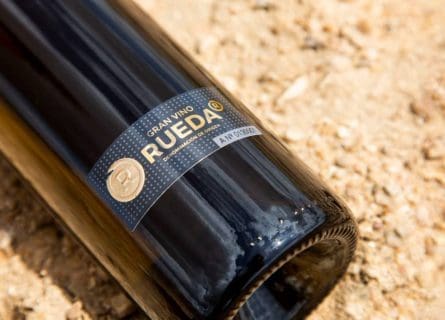
In just over 40 years, Rueda’s dynamic firmament of producers has transformed a once-unknown backwater into one of Spain’s leading white wine regions. As a result, Rueda is rapidly becoming a household name and may threaten Sauvignon Blanc’s global supremacy. It has sufficient capacity, a bold vision, and the cachet. Rueda has the domestic – and increasingly international – market for aromatic wines sown up.
Yet despite achieving this success, the region’s dynamic wineries continue to drive innovation and push for higher quality standards in the DO. In recent times, the use of oak has become a hot topic, with some wineries choosing to ignore the lure of barrel fermentation and aging. In contrast, others insist it adds an extra dimension to an already well-established wine. In addition, barrel-fermented versions are increasingly becoming fashionable and add weight and texture, although some feel that this detracts from the pure, saline quality of Rueda.
Gran Vino de Rueda
The crux of the argument concerns Rueda’s future as a major player in premium white wines. There is a growing firmament of producers who wish to broaden the style’s appeal and tap into the super-premium/luxury segment. This was the catalyst behind unveiling the Gran Vino de Rueda category in 2020 – the DO’s first stab at a stratified wine hierarchy.
To qualify as a Gran Vino de Rueda, growers must source their fruit from old vines (over 30 years old) and harvest a restricted yield of 6,500kg per hectare. In addition, only 65% of the total yield can be made into wine. Many of the best cuvées are matured in wood for over 12 months, adding structure and complexity to the final product.
The Future of Rueda
What emerges in your glass resembles white Rioja: pungent and full-bodied, with a depth that unoaked Verdejo can sometimes lack. Does Gran Vinos represent Rueda’s new face? Probably not – the market continues to demand saline whites at affordable prices. However, diversification into the luxury segment can do no harm to the region. Rueda has added a new string to its bow.
Chardonnay is a green-skinned grape varietal native to the Burgundy wine region in France and one of the most popular varieties worldwide.
Find out moreThe sauvignon blanc grape varietal, originally from the Bordeaux region of France, is now one of the world's most loved white varieties.
Find out moreUnveiling Verdejo: Spain's Rueda Wine Region's Prized White Grape. Explore the Crispness and Lightness of this Dry White Varietal.
Find out moreViognier comes from the northern Rhône valley AOC of Condrieu and is where its most famous white wines are produced.
Find out moreDiscover Viura: Rioja's Prominent White Grape & Catalonia's Macabeo. Explore its versatility in exquisite wines. A must-read for wine enthusiasts.
Find out moreGarnacha: Spain's Red Gem. Akin to Pinot Noir, it bridges terroir and winemaking, crafting captivating expressions.
Find out moreMerlot is the most cultivated grape in Bordeaux and closely related to Cabernet Franc
Find out moreDiscover Tempranillo: Spain's iconic red grape. From Ribera del Duero to Toro, it yields concentrated wines. Explore its synonyms and unleash its prowess.
Find out moreCastilla y Leon is renowned for the quality of its meat: exquisite roast suckling pig, milk-fed lamb, wild boar, and seasonal game. Yet a chilled glass of Rueda calls for something on the lighter side. Fear not: plenty of freshwater fish is available in the region’s many excellent restaurants, prepared by chefs who value traditional recipes and fresh ingredients above all else. But, for many visitors, the true magic of dining out in Spain is wandering from tapas bar to tapas bar, drinking in the atmosphere with a glass of Verdejo in tow.
Guide to the gastronomy of Castilla y Leon: Read more

Immerse yourself in Burgos's vibrant flavors and uncover hidden culinary gems with our expert insider guides. Plan an unforgettable trip today!
Read more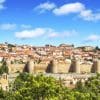
Uncover the captivating wine region of Castilla y León, where tradition meets innovation. Explore heritage, flavors, and vineyards. Plan your trip now!
Read more
Immerse yourself in Segovia's vibrant flavors and uncover hidden culinary gems with our expert insider guides. Plan an unforgettable trip today!
Read moreIf you would like us to customize an exclusive luxury tour, contact us and let us know your travel plans. We offer luxury food and wine tours for private groups of a mininium two guests. In addition, all of our private, chauffeured tours are available year-round upon request.

